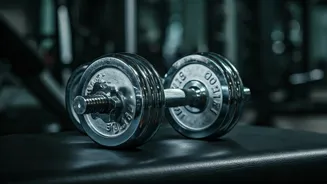Foot and Seat
Proper foot and seat positioning are crucial for a stable and effective dumbbell shoulder press. Your feet should be flat on the floor, shoulder-width
apart, providing a solid base. When seated, ensure your back is straight and supported by the bench. The seat's height should allow your feet to remain flat, with your thighs parallel to the floor. This posture provides a stable foundation, which can reduce the chance of injury and ensures you are able to focus on lifting. A good foot and seat position will transfer maximum power during the press.
Pre-Checklist Essentials
Before you even think about lifting, a pre-check is a must-do. This involves checking that your equipment is set up correctly. First, make sure the bench is at a proper angle to allow for comfortable execution. Also, ensure the floor is clear of any obstacles. Having a spotter to help monitor your form and assist in case you struggle with a rep is something to consider. The green light checklist starts here. This careful preparation sets the stage for a safe and efficient workout, helping you concentrate on the movement and maximize the benefits of each press.
Breathe and Brace
Breathing and bracing are key aspects often overlooked. Take a deep breath before each repetition, filling your belly with air, not just your chest. This action will help stabilize your core. Engaging your core muscles, as if you are preparing to be punched in the stomach, can further enhance stability. As you press the dumbbells upwards, maintain the braced core and controlled breathing, exhaling as you push the weight. This breathing and bracing technique can help stabilize the spine, which can make the lift safer, while allowing you to lift more weight.
Get Into Position
Getting the dumbbells into the starting position can be tricky. The 'pick-up and lap position' is a useful technique to help you get ready. Carefully pick up the dumbbells from the floor. Then, rest each dumbbell on your thighs near your knees. While maintaining this position, sit on the bench. Once you are seated with feet planted, use your thighs to 'kick' the dumbbells up and into position at shoulder height, with your palms facing each other or slightly forward. This method minimizes strain and sets you up for a controlled press. Keeping the dumbbells close to your body during the 'kick' up is an added advantage as it reduces energy expenditure.
Common Mistakes
Avoid these common mistakes. First, a common mistake to avoid is arching your back excessively. This can put undue stress on your lower back. Keep your back straight and in contact with the bench. Second, avoid letting your elbows flare out too wide during the press. This places unnecessary strain on your shoulders. Keep your elbows slightly tucked in, at about a 45-degree angle to your body. Third, ensure you are not using momentum to lift the weight. Focus on controlled movements throughout the entire range of motion. Finally, avoid overextending your arms at the top, potentially locking your elbows and risking injury. Maintaining proper form will maximize your gains while minimizing the risk of injury.







